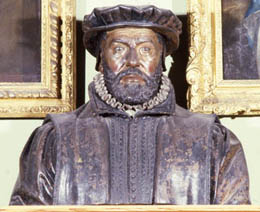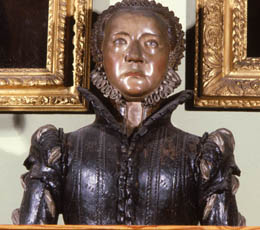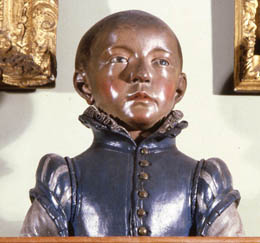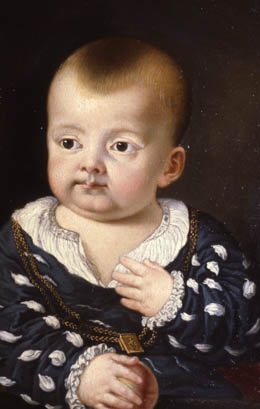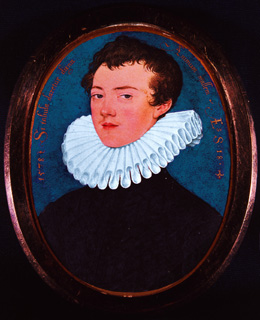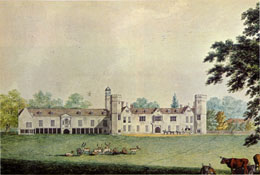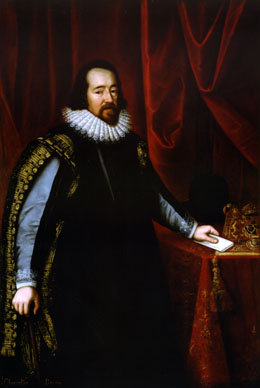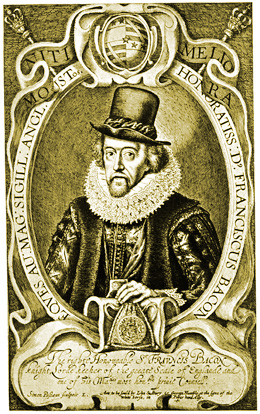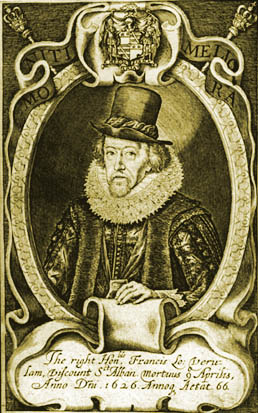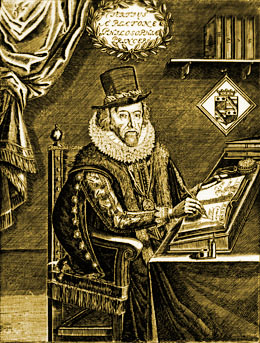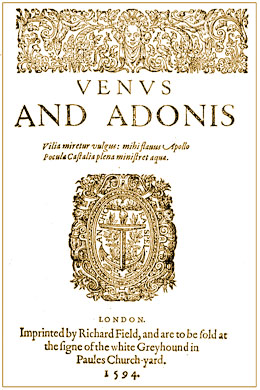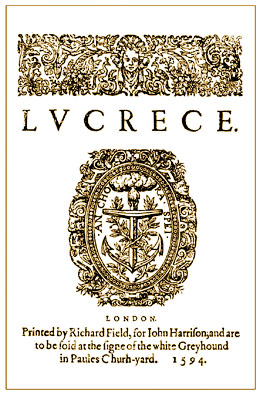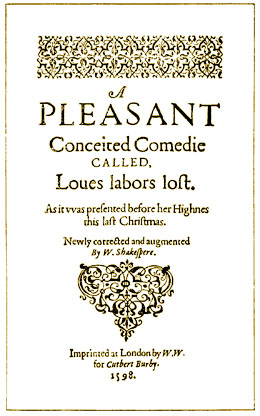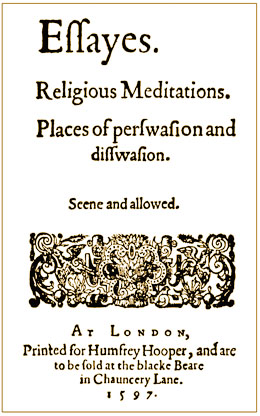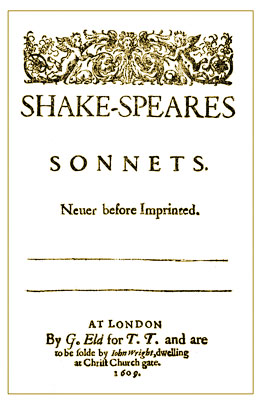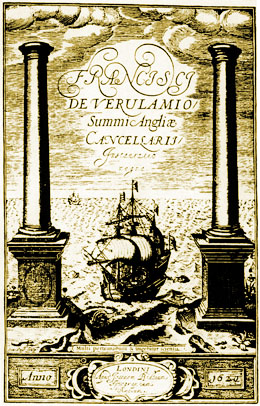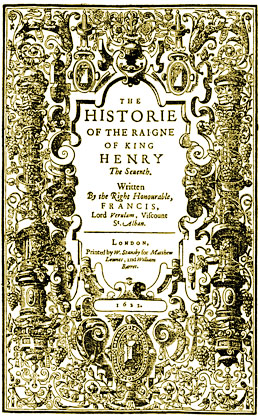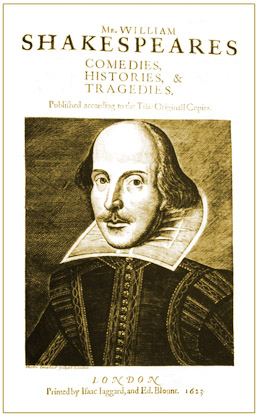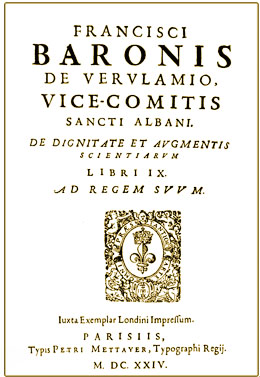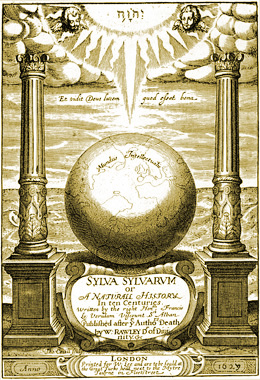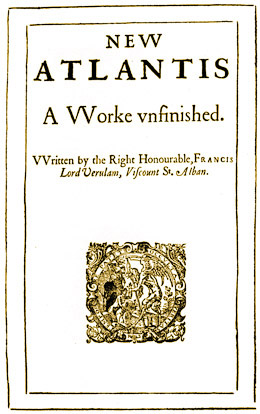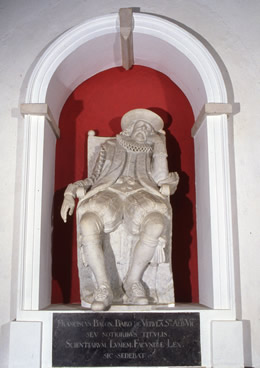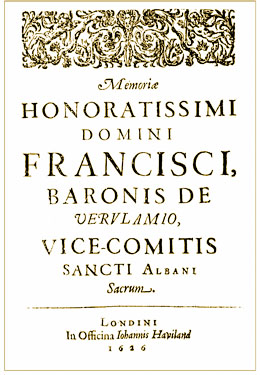Baconian History
“My conceit of his person was never increased toward him, by his place, or honours. But I have and do reverence him for the greatness that was only proper to himself, in that he seemed to me ever, by his work, one of the greatest men and most worthy of admiration that had been in many ages.”
Ben Jonson: Tribute to Francis Bacon, Explorata, or Discoveries – 1641
Birth, Upbringing and Education
Francis Bacon was born at York House, Charing Cross, London, on 22 January 1561. He was baptised at St Martin-in-the-Fields on 25 January 1561 as second son of Sir Nicholas and Lady Ann Bacon. His father was Lord Keeper of the Great Seal of England and his mother was one of the most highly educated and accomplished women of her time, second daughter of the great scholar and humanist, Sir Anthony Cooke, and sister of Sir Anthony’s eldest daughter, Mildred, wife of Sir William Cecil, Principal Secretary of State, who later became Lord Burghley (1571) and the Queen’s Lord High Treasurer (1572). Both Sir Nicholas and Sir William, besides holding the highest political offices under Queen Elizabeth, were patrons and active promoters of the arts and sciences. The two families, the Cecils and the Bacons, maintained close contact with each other and often visited each other’s homes.
As a child Francis showed more than unusual promise and attracted the attention of Queen Elizabeth, who liked to call him her “young Lord Keeper”. Together with his brother Anthony, he was given a privileged private education by the best teachers of the time, which took place mainly at York House, the Lord Keeper's London residence—a thriving hub of State business that adjoined York Place, the Queen's Palace of Whitehall, or in the vacations at Sir Nicholas’ country home of Gorhambury, St Albans, with visits to Theobalds House, Sir William Cecil’s nearby country estate, and Gidea Hall, the country home of Sir Anthony Cook, Francis’ learnèd grandfather and principal tutor. 1 Francis also had regular access to Cecil House, the London mansion of his uncle, which operated as a school for young noblemen who included, at one time or another, the Earls of Oxford, Surrey, Rutland, Southampton and Essex, plus Fulke Greville and Sir Philip Sidney.
Because of Sir Nicholas’ high office, Francis was likely to have been present at various Court entertainments, such as the regular Christmas festivities and the Kenilworth Entertainment laid on for the Queen at Kenilworth Castle by her favourite, Robert Dudley, Earl of Leicester.
Francis’ “dearest brother”, “comfort” and “second self”, Anthony, two years Francis’ senior, was brought up and educated with Francis. The two brothers became thoroughly learned in the Classics and fluent in Latin, Greek, Hebrew, French and Italian. They also learnt Spanish and Dutch, studied mathematical subjects and music, played the lute, and were proficient in the art of fencing and horse riding. In addition to all this they learnt classical mythology and philosophy, and had a thorough grounding in the scriptures. Sir Nicholas was a principal advocate of ‘the advancement of learning’ style of education initiated by Sir Thomas More and promoted by the secret society founded in London by Heinrich Cornelius Agrippa in 1510—a society that adopted the name and symbolism of the rose and cross from c.1570 onwards. 2
In April 1573, at the age of twelve, with a “new star” blazing away in the heavens (a supernova in Cassiopeia), Francis entered Trinity College, Cambridge University, accompanied by his brother Anthony. They were placed under the direct charge and tuition of the Master of Trinity, Dr John Whitgift, and lodged in rooms under his roof. (Whitgift afterwards became Archbishop of Canterbury.) Their contemporaries and friends at Cambridge included John Lyly, William Clerke, Edmund Spenser, Philemon Holland and Gabriel Harvey—the latter being their tutor in rhetoric and poetry.
Whilst a student at Cambridge, Francis became thoroughly disillusioned with the Aristotelian system of thought and teaching. As a reaction to this, and inspired with prophetic vision as to what to do to improve matters, his grand idea was born, revealing to him his mission in life. Less than two years later, at Christmas 1575, he and Anthony left Cambridge, carrying with them the embryo of a plan by means of which Francis’ grand idea might be set in motion and gradually achieved. In this project Anthony was a dedicated partner, even though for the next fifteen years their respective paths would separate them physically for most of the time.
France
On 27 June 1576 Francis, aged fifteen, and Anthony, aged seventeen, were entered as law students at Gray’s Inn, one of the four Inns of Court in London, to follow in their father’s footsteps. Five months later they were admitted, together with all of Sir Nicholas Bacon’s sons, to the Grand Company of Ancients by Order of Pension dated 21 November 1576. However, instead of taking up residence at Gray’s Inn immediately, Francis was sent abroad to further his education. In this, Francis was following the special course of education that had been delineated by Sir Nicholas Bacon “for the advancement of learning and training of statesmen”—a name and course of action that was to be enlarged upon and incorporated by Francis into his Great Instauration. 3
Francis was appointed as an attaché to Sir Amyas Paulet, his French tutor, who had been knighted and commissioned by Queen Elizabeth as the new English Ambassador to the French Court. Also accompanying Francis was Mr Duncombe, a tutor in diplomacy, and Francis’ half-brother Edward Bacon. Both Francis and Edward were granted a licence to travel on the continent for a period of three years, together with their servants, “for their increase in knowledge and experience”. 4
The embassy set out for France on 25 September 1576 and landed at Calais later that day, from whence they travelled on to Paris and the court of Henri III. Edward seems to have parted company with the party shortly after landing, as he intended to visit such places as Padua, Ravenna and Vienna (and in December 1577 he was in Strasburg). 5
The embassy happened to arrive in the middle of the French Wars of Religion when, on one hand, the functions of the French State were in disorder and, on the other hand, the French Renaissance was at its height. This was a time when, despite the corrupt level of French politics, the French court was abuzz with cultural activity and splendour, and the French philosophers, humanists, artists, musicians, scholars and poets (such as the renowned Pléiade 6 of French poets) were at their height of fame. They formed a royal academy (the Palace Academy) patronised by the king of France, Henri III.
During his sojourn abroad, Francis studied the laws, customs, history and culture of France, gained experience in diplomacy, made contact with Henri de Navarre’s Huguenot ministers, and became involved with the philosophers and poets, including the esoteric movement or society founded in Paris by Agrippa that was twin to the Rosicrucian society in England. He also worked for the Queen's intelligence service, decrypting information and inventing cipher systems, including the Biliteral Cipher which later inspired the creation of the Morse Code and the binary code of modern computer technology. As a member of the English embassy, he travelled with the French court to Fontainebleau, Blois, Tours, Poitiers and Chenonceaux, as well as living in Paris where the French court was normally based. Besides the pageantry, grand entertainments, feasting, walking, riding, hunting, philosophical discussions, political intrigues and affairs of one kind or another, Francis had the opportunity to see performances of the Italian Commedia dell’ Arte at Blois in February 1577 and at Paris in the following years. In August-September 1577 Francis made some kind of perilous journey, which may refer to his brief visit to England when he was entrusted by Paulet with “some message or advertisement to the Queen”, for which he was commended (or else he made two separate journeys).
Return to England – Areopagus – Gray’s Inn – Intelligence
Francis was making preparations to travel to Italy when, on the night of 17/18 February 1579, he dreamt that Gorhambury was plastered all over in black mortar. Two weeks later he received news that his father had unexpectedly died on 20 February. Francis set off for England as soon as he could, bearing a despatch from Sir Amyas Paulet to the Queen. The Lord Keeper’s funeral took place on 9 March 1579.
One of the results of this unfortunate death was that Francis was left with very little financial support of his own, as Sir Nicholas had died before he had been able to complete arrangements for a suitable inheritance for Francis. However, one of the things that Francis did inherit was Sir Nicholas' share in the Company of Mineral and Battery Works, a mining company set up to produce brass plates and iron wire, in which Francis already had a deep scientific interest and which influenced the development and language of his philosophical programme.
It is not recorded where Francis Bacon lived during the first few months after Sir Nicholas Bacon’s funeral, but by the beginning of October (the start of the legal year) he would have taken up residence in Gray’s Inn so as to continue his law studies, as pre-arranged by his father and now supervised by Lord Burghley. He was certainly well ensconced there a year later, as recorded by an entry dated 13 May 1580 in the Gray’s Inn Pension Book, which notes that “Mr Francis Bacon in respect of his health is allowed to have the benefit of a special admittance.” This meant that Francis was freed from the obligation of keeping Commons and could choose his diet and take meals in his chambers. In addition he had been admitted to the Grand Company of Ancients, which meant that he (and his brother Anthony) could come and go as he liked, without regard to the Inn’s formal teaching arrangements and without being bound to any vacations (i.e. learning vacations, as distinct from holidays and terms).
However, law was not Francis’ great interest. In later years he informed Dr William Rawley that law was to him but an accessory, not his principal study, even though in law, according to Rawley, “he obtained to great excellency” and “in the science of the grounds and mysteries of law he was exceeded by none”. Francis’ passion in life was philosophical, scientific, poetic, educational and philanthropic, and devoted to the realisation of his grand idea, which was none other than a renovation of all arts and sciences based upon the proper foundations. It was a grand concept—one that he was later to call “The Great Instauration” or “Six Days Work”.
To help him in his educational and cultural endeavours Francis applied to his uncle Lord Burghley to exert influence with the Queen on his behalf, in recognition of his special abilities and circumstances, so that he might have not only royal approval but also a position whereby he could have sufficient influence and income, without having to practice law, to give him “commandment of more wits” than his own to assist him in his proposed task. In this, Francis was probably thinking of the royal patronage and financial support given to the Palace Academy and the Pléiade in France. In letters he not only confessed that he had “as vast contemplative ends as [he had] moderate civil ends”, for he had “taken all knowledge as his province”, but he also made clear that neither law nor government officialdom was his desired occupation or interest, but “philanthropia” and “the waters of Parnassus” (the Castalian Spring, dedicated to the Muses, that provides poetic inspiration to those who bathe in or drink its waters). The Queen, who was interested in the French academies and fond of grand entertainment, and Burghley, who was a patron of scholars and musicians (but not poets), gave Francis to believe that such a place would be found for him; but, other than moral and verbal encouragement, in this “rare and unaccustomed suit” Francis was to meet with little success.
Besides studying law, developing his grand scheme, taking part in the various activities of Gray’s Inn and being “sometimes a courtier”, 7 Francis also assisted in the compilation and assessment of political intelligence, working with Sir Francis Walsingham, the Queen’s Secretary of State, who had set up and headed one of the most efficient intelligence networks then in existence. Part of this work was cryptography and cryptanalysis, which Francis carried out together with Thomas Phelippes, Walsingham’s leading code-breaker.
One of those supplying intelligence was Anthony Bacon who, at the behest of Burghley as well as his own personal desire, travelled Europe (France, Switzerland, Navarre) from 1579 to 1592 gathering intelligence of various kinds, building a network of friends and agents, acting as a diplomat, and sending his brother items of literary and philosophical interest. In the process Anthony became a personal friend of the Protestant theologian Theodore Beza, the Huguenot king Henry of Navarre (later Henry IV of France), and the French essayist Michel de Montaigne. One result of this intelligence work was that, in 1582, Francis Bacon was involved in creating a report or State Paper for the Queen entitled Notes on the Present State of Christendom.
All in all, Francis Bacon was at the heart of and privy to a huge web and data bank of intelligence on all kinds of matters, from politics, economics, law, trade, history, geography, science, literature, poetry, military strength and religious beliefs, right down to social customs, manners, costumes, personal behaviour, travel facilities, environmental details and individual experiences, at home and abroad. Moreover, besides his brother Anthony, his friend Thomas Phelippes and his mentor John Dee, others in the intelligence service whom Francis would have known and worked with included Walsingham’s secretaries, Nicholas Faunt, Francis Milles, William Waad and Robert Beale, and the poets, Edmund Spenser, Thomas Watson, Samuel Daniel, Christopher Marlowe and Anthony Munday, who acted periodically as agents.
Member of Parliament – Barrister – Queen’s Counsel – Great Instauration
In 1581 Francis Bacon began his thirty-six years of Parliamentary service as a Member of Parliament, entering the Commons as a member for Cornwall. On 27 June 1582 he was called to the Bar and admitted Utter Barrister at Gray’s Inn. His involvement in high politics started in 1584, when he wrote his first political memorandum, A Letter of Advice to Queen Elizabeth, and in March 1584 he visited Scotland. By 1585 he had composed his first “juvenile” work, Temporis Partum Maximum ('The Greatest Birth of Time'), on what was later to become publicly known as ‘The Great Instauration’. On 10 February 1586 he became a Bencher of Gray's Inn. Then, less than two years later, on 23 November 1587 he was appointed a Reader of Gray’s Inn.
From that time (1587) onwards we learn that Francis was regularly associated with other gentlemen of Gray’s Inn in devising and presenting masques and entertainments at Gray’s Inn and the royal Court at Greenwich, and writing speeches and devices to be used in the Queen’s Accession Day Tilts.
Francis’ movements tended to oscillate between Gray’s Inn, the royal Court when he was in attendance on the Queen, and Twickenham Lodge. The latter was situated in Twickenham Park, the Crown property leased by Edward Bacon, with land leading down to the River Thames immediately opposite the Queen’s palace of Richmond. The lodge with its park was a tranquil and beautiful place where Francis could write in peace, together with his friends and “good pens”. Edward seems to have allowed Francis the use of Twickenham Lodge whenever he wanted. It is here that Francis carried out his early experiments related to his Great Instauration project and, with the help of his team of “good pens”, wrote poetry (masques and plays) and intelligence reports. In November 1595, when Edward's lease of Twickenham Park expired, the Queen granted the lease to Francis. Francis had the use of the lodge and its parkland until 1606, when he surrendered the lease. He also made occasional visits in the vacations to Gorhambury, the country mansion built by Sir Nicholas Bacon on the outskirts of St Albans. Although inherited by Anthony Bacon, Gorhambury was, under the terms of Sir Nicholas Bacon's will, Lady Anne Bacon's home and residence for the rest of her life.
In 1591 Francis appears to have almost given up his fruitless “rare and unaccustomed suit” with Burghley and the Queen. At about the same time he struck up a good friendship with Robert Devereux, 2nd Earl of Essex, whom he had known since their youth. The earl was fast becoming the foremost favourite of the Queen and a popular hero with the people. Francis, completely disillusioned with and thwarted by his uncle Burghley, decided to assist Essex in every way possible, believing him to be “the fittest instrument to do good to the State”, but always with the reservation that his first duty was to the Queen. Essex in turn promised to help Francis. Ultimately this turned out to be a perilous mistake for Francis. Essex’s temperament was so hot-headed and imperious that, rather than helping Francis, he repeatedly made matters worse, with the Queen and Essex clashing like gladiators. Burghley and Robert Cecil came to loathe Essex, resulting in their admitted policy of doing their utmost to block the advancement of any of Essex's friends, including the Bacon brothers.
At some unrecorded moment in time—but which, from various evidence, would seem to have been in 1592—the Queen appointed Francis Bacon as her Counsel Learned, Extraordinary. This was a completely new position, specially created for Francis, which brought him “within the bar” with the judges and Serjeants-at-Law, and gave him a standing with the serjeants. 8 His duties were not clearly defined, but, besides the fundamental duty of conducting court work on behalf of the sovereign, they encompassed a wide spectrum. However, as an ‘extraordinary’ rather than an ‘ordinary’ position, it was an unpaid one and without a pension or a regular means for accumulating fees. It didn’t solve Francis’ financial predicament, but it gave him a special standing and enabled him to enjoy privileged ‘near’ access to the Queen. This was the first such appointment, given by patent from the ruling sovereign, and was the birth of what later became known as the Queen's (or King's) Counsel, or 'QC' for short.
Anthony Bacon – Intelligence Network – Shakespeare Circle
In February 1592 Anthony Bacon returned home from the continent. Anthony, whom Francis called his “dearest brother” and “comfort”, shared Francis’ aspirations. His main love was literary and, like his brother, he was a secret poet, known only as such to his friends, as revealed in their letters to him. All the time he was abroad he had kept in communication with his brother Francis as well as with his uncle Burghley and Sir Francis Walsingham.
Anthony Bacon’s foreign contacts were wide-spread and he enjoyed friendship in many high places, “being a gentleman whose ability the world taketh knowledge of for matters of state, specially foreign”. 9 His contacts and friendship with Henri de Navarre, later Henri IV of France, were later incorporated into the Shakespeare play, Love’s Labour’s Lost, as also was the result of his association and friendship with the King of Spain’s Secretary of State, Antonio Perez, who defected to England and upon whom the Shakespearean character of Don Adriana de Armado is based.
When Anthony returned to England, he first of all joined his brother at Gray’s Inn and started to pour all his energy and financial resources into his brother’s project whilst at the same time continuing his intelligence work. Together the brothers formed a team of secretaries and writers to assist them, dealing with foreign and home intelligence of all kinds, cryptography, translations of correspondence and books in foreign languages and the classics, and the writing of poetry (masques, plays, devices, etc.). Francis also “knit” Anthony’s service to the Earl of Essex, and from that time onwards Anthony developed and ran an intelligence service for Essex rather than for Burghley, so that Essex would have the chance of better intelligence than Burghley with which to inform the Queen and be kept in her high favour. Key assistants in this team included Thomas Phelippes, Anthony Standen, Henry Wotton and Nicholas Faunt, who between them had travelled in and gathered detailed intelligence of all kinds and over many years from France, Italy, Spain, Germany, Switzerland, Austria, Transylvania, Poland and Turkey.
Later that year Francis composed a dramatic device (i.e. spectacle or show) called A Conference of Pleasure, for Essex to present at the Queen’s Accession Day Tilt on 17 November 1592.
By now, Francis’ literary and poetic endeavours had become closely entwined not only with members of Gray’s Inn and other Inns of Court but also with Essex and his circle of friends. This ‘Essex group’, which had been linked with Robert Dudley, Earl of Leicester, Sir Francis Walsingham and Sir Philip Sidney until their deaths in the 1580’s, and with the Areopagitae of English poets that used to meet at Leicester House (later Essex House), included: Robert Devereux, 2nd Earl of Essex; Henry Wriothesley, 3rd Earl of Southampton; Ferdinando Stanley, Baron Strange, 5th Earl of Derby; William Stanley, 6th Earl of Derby; Charles Blount, 8th Baron Mountjoy; Frances Walsingham, Countess of Essex, Essex’s wife, daughter of Sir Francis Walsingham and widow of Sir Philip Sidney; Penelope Rich, Essex’s sister, wife of Robert Rich, 3rd Baron Rich, and, after his death in 1586, Mountjoy’s mistress; Elizabeth Vernon, Essex’s cousin and Southampton’s mistress (whom Southampton married in 1598); and Mary Sidney, the Countess of Pembroke, sister of Philip Sidney and mother of “the Two Noble Brethren”, William and Philip, to whom the 1623 Shakespeare First Folio was dedicated. To these should be added Fulke Greville, Francis Bacon and Anthony Bacon.
Associated with this group of aristocrats and friends were other poets, writers and dramatists whom the group patronised, which included Samuel Daniel, Ben Jonson, John Florio, George Wither, Edmund Spenser, Thomas Nashe and John Lyly. Thomas Lodge, George Peele, Robert Greene and Christopher Marlowe were also connected with this group. In effect, the overall group of patrons and poets formed what might be called ‘The Shakespeare Circle', with direct access to acting companies.
Mary Sidney’s husband, Henry Herbert, 2nd Earl of Pembroke, whose country estate at Wilton borders on the Wiltshire River Avon, was the patron of his own professional acting company, the Lord Pembroke’s Men, who had in their repertoire several of the earliest Shakespeare plays. Their tour of 1592-4 featured The Taming of a Shrew (an earlier version of the one published in the Shakespeare Folio), Titus Andronicus and 3 Henry VI. Titus Andronicus was also performed by Sussex’s Men and Derby’s Men. The latter company was that of Ferdinando Stanley, Baron Strange, who became the 5th Earl of Derby on his father’s death in 1593. Previous to that the company had been known as the Lord Strange’s Men, who gave what might have been the first performance of 2 Henry VI at The Rose playhouse in 1592. When Ferdinando Stanley died in 1594, most of the members of Derby’s Men joined the newly reconstituted Lord Chamberlain’s Men under the patronage of Sir Henry Carey, 1st Baron Hunsdon, and the leadership of the Burbages. (See ‘Acting Companies’.)
Royal Disfavour – Birth of ‘Shakespeare’ – Venus and Adonis
Francis Bacon’s new position was severely challenged in the Parliament of January-March 1593. He appeared there as an MP representing Middlesex, and took part in various debates and motions and committee meetings. The challenge, though, came about when he opposed an attempt by the Queen and House of Lords to diminish the House of Commons’ vitally important prerogative of raising taxes and discussing such matters in private. He also thought that the triple subsidy (taxation) to be raised in three years that was being demanded by Burghley on behalf of the Queen and Lords, rather than the two subsidies raised in four years that had at first been proposed by the House of Commons, would be too great for ordinary people to bear; and so, although agreeing that a substantial subsidy was needed to offset the costs of defending the country against the Armada, he recommended that the proposal be moderated somewhat. In the end it was agreed by the Commons that three subsides would be provided, spread over four years. The Queen was furious at Francis’ behaviour, and immediately made him feel her displeasure. He was denied access to her presence and told “that he must nevermore look to her for favour or promotion”.
Very soon after this, in June 1593, ‘William Shakespeare’ as an author’s name was officially launched onto the public scene for the first time with the publication of the highly scholarly, erotic poem Venus and Adonis. Notably, it had been entered into the Stationers’ Register on 18 April 1593, a date close to St George’s Day, 23 April, the legendary birthday of William Shakespeare. This, the “first heir” of Shakespeare’s “invention”, was dedicated to Southampton, as was the second Shakespeare poem, Lucrece, published the next year (1594). A few years later, the writer Joseph Hall and poet John Marston, in an exchange of satires published during 1597-8, stated that the true author of the poems was a jurist, whom they nicknamed “Labeo”, who used a living person, a “swain”, to mask his authorship. They ultimately identified “Labeo” as Francis Bacon.
The royal disfavour precipitated a major crisis for Francis. In an attempt to prove his worth to the Queen, Burghley and others as a barrister and Queen’s Counsel, as well as to earn some money, Francis pleaded his first case in the King’s Bench and Exchequer Chamber in January 1594, and his second and third in February. His first pleading was so successful that Burghley, content with Francis as a lawyer and pressured by his own family who had taken pity on Francis' predicament, undertook to make a report "where it might do him the most good".
The Queen played a game of punishment or reward with Francis, trying to make him her creature in all ways, including the Parliamentary one. In 1594 the position of Attorney-General fell vacant and was kept vacant for a whole year, and several times it was intimated to Francis that the Queen might appoint him to this position and that it was only his conduct in Parliament that stood in the way. Essex, eager to help Francis, urged the Queen to make this appointment; but Francis would not recant and there were other factors afoot. Robert Cecil suggested to Essex that if Sir Edward Coke, the Solicitor-General, were to be appointed as Attorney-General, which he felt the Queen would prefer, then perhaps Francis might be content with the lesser position of Solicitor-General instead. But Essex would not have it; only the higher office would do for the friend of Essex! As Essex saw it, his own reputation was at stake.
Francis was in a difficult situation. He didn't really want the onerous legal position of Attorney-General, but he needed a position that brought him sufficient income as well as standing. Creditors were a continual problem, as his project was costly and he never had enough money.
It was about this time that Fulke Greville began to take an active part on Francis' behalf with the Queen. Whether because of this, or because Francis declared his intention of retiring to Cambridge with a couple of men to spend his life in studies and contemplation, there seemed to be a shift in the Queen's demeanour towards Francis. In May 1594 she appointed Francis as the Deputy Chief Steward of the Duchy of Lancaster. Also, that summer, the Queen conferred on Francis some woodland in Somerset at a nominal rent, from which he could raise some finance. In June 1594 he was appointed to assist the investigation into the 'Walpole Plot' (associated with the Lopez conspiracy); and, on the 18 or 19 July 1594, he set out for the north on some important business of the Queen. However, on this mission he only reached as far as Huntington when he fell ill, writing to tell the Queen of it on 20 July. As we next learn that he was in Cambridge on 27 July to receive his degree of Master of the Arts at a specially convened ceremony, the assumption is that, because of his brief illness, his mission was aborted. In August-September 1594 Francis was back in London, examining prisoners on behalf of the Queen in yet another Catholic conspiracy.
Gray’s Inn Revels – Knights of the Helmet, Comedy of Errors
During 1594 Francis Bacon was one of the two Treasurers of Gray's Inn, which appointment ran until 26 November 1594. As head of the Inn, the Treasurer was responsible for the Gray's Inn revels, and for the end of that year the Inn planned to hold extra-grand Christmas Revels. Because the revels had been intermitted for three or four years, the Inn was determined to redeem this lost time with something out of the ordinary, and they specifically asked Francis to redeem their good name in this respect. The revels were by custom designed, organised, written and performed by the members of the Inn, as part of their education and training for both the court of law and the royal court. These particular revels would have needed to be prepared some time in advance and this could explain why, at some point during the summer of 1594, Francis explained in a letter to Essex that he neither had much hope nor much desire for the position of Solicitor-General—the lack of desire or appetite being because he was so preoccupied with "the waters of Parnassus" which almost entirely quenched his thirst for other things, and the lack of hope because his only real reason for having the office, other than serving the Queen, was so as to be able to pay off his old debts and take on new ones.
The revels were called The Prince of Purpoole and the Honourable Order of the Knights of the Helmet and took place over the Twelve Days of Christmas. The theme of the revels was built around the idea of errors being committed, disorder ensuing, a trial being held of the 'Sorcerer' responsible, who then restores order and transmutes everything to a higher and better level than before. The first Grand Night took place on the evening of Holy Innocent's Day, 28 December 1594. As prearranged, the masque ended abruptly in general confusion and the special guests, the Inner Temple barristers, returned to their Inn, feigning offence. Those who remained were then set to "dancing and revelling with gentlewomen", after which the Shakespeare play, A Comedie of Errors like to Plautus his Menæchmi, was performed by torchlight.
The following day a mock trial was held. The 'Sorcerer' or 'Conjurer' (Francis Bacon) then conjured up a new entertainment called The Honourable Order of the Knights of the Helmet, which was presented on the second Grand Night, 3 January 1595, the Feast of the Most Holy Name of Jesus. In this entertainment Francis Bacon presented his philosophical ideals and an Order of knighthood dedicated to carrying them out. The purpose of the Order was to correct the errors of the past and bring order out of chaos. The name of this philosophical Order of knights refers to the divine Spear-shaker, Pallas Athena, the Tenth Muse and Patroness of the Arts and Sciences, whose helmet guards the sacred diadem of the Prince of Purpoole. In addition, the goddess presents helmets to her knight-heroes, hence the Order of the Knights of the Helmet. These helmets were said to bestow invisibility on the wearer as well as being 'will helms' (the derivation of 'William'), meaning 'helmets of strength', a symbolism that has the further cabalistic meaning of righteousness, virtue, clear perception and judgement. All such knights are, metaphorically, spear-shakers or shake-speares, like the Gemini and St George. They are also 'invisible brethren', a term used to describe the Rosicrucian fraternity.
In this entertaining and dramatic way, these Christmas Revels presented Francis Bacon's grand project for the complete reformation of philosophy and regeneration of all arts and sciences, thereby bringing order out of chaos, and knowledge of truth out of ignorance and confused thought. Sadly the last two Grand Nights were cancelled, but there are several indications that on one of those nights it had been intended to perform Love's Labour's Lost.
Royal Entertainments and Reconciliation – Essays
In October 1595 Anthony Bacon moved into Essex House to act, in a voluntary way, as the earl's virtual 'secretary of state'. In November 1595 the Queen formally appointed Coke as Attorney-General and Serjeant Fleming as Solicitor-General. Essex was mortified by this result, feeling it as a matter of pride, and bestowed on Francis a gift of land (assumed to be adjoining Twickenham Park) in recompense for what he felt was his failure to help his friend. Francis was able to raise money on this land to ease his situation, and later he sold it.
For the Queen’s Accession Day celebration on 17 November 1595, Francis wrote The Philautia Device and The Device of the Indian Prince for Essex to perform before Elizabeth, which helped to reconcile her to Essex (who had, thanks to a book published abroad, been under a shadow of suspicion concerning his influence with the Queen upon the matter of succession). As a result the Queen was not only reconciled to both Essex and Francis but she also granted Francis the reversion of the lease of Twickenham Park. A year later (November 1596), Francis was again involved in composing a device for the Accession Day Tournament, this time for Robert Ratcliffe, the fifth Earl of Sussex.
In January 1597 Francis had a book published under his own name of ‘Francis Bacon’ for the first time, this being the first version of his Essays, which he dedicated with affection to his “Loving and beloved Brother”, Anthony, “you that are next myself”. Not only was Anthony Francis' brother, friend, co-writer and partner in Francis' grand scheme, but also Anthony was the main provider of the limited finance available for the brothers to live on and the work to be sponsored.
Courtship – Merchant of Venice – Essex’s Insurgency
Besides his deep brotherly love for Anthony, Francis was enamoured of his cousin, Elizabeth Cecil, one of Burghley's grand-daughters, with whom he had flirted when younger. He continued his friendship with Elizabeth after she was married to Sir William Hatton in 1594, which friendship deepened over the years. When Elizabeth was widowed in 1597 Francis courted her seriously, requesting her hand in marriage. She had been left a very wealthy young woman by her deceased husband, and so marriage with her could bestow a double grace and solve Francis' financial problems. But another disappointment was in store, and once again Sir Edward Coke, now Attorney-General and wealthy, won the day. A romanticised account of this courtship, turned into an allegory, can be seen to underlie the Shakespeare play, The Merchant of Venice, as also the friendship between Francis and Anthony, the difficulties they endured through being forced year after year to raise loans from usurers, and the potential bankruptcy of Anthony on his brother's behalf.
In 1599 trouble between the Queen and Essex flared up dangerously, with Essex consistently acting against the advice of Francis Bacon who, knowing the Queen's wishes, urged Essex not to seek a military position and not to go to Ireland at the head of the English army—both of which Essex nevertheless did. Essex was appointed Lord Lieutenant of Ireland on 24 March 1599 and set out for that country at the head of 17,000 troops with orders to put an end to the rebellion led by the Earl of Tyrone.
Just before Essex set out for Ireland, a potentially volatile situation arose, in which the Shakespeare play of Richard II was indirectly involved. A book based on the play had been published by a young doctor of civil law, John Hayward (a friend of both Essex and Francis Bacon), which in its preface likened Essex to Bolingbroke and seemed to exhort Essex to rise up against the Queen and usurp the throne. Hayward was arrested and threatened with torture. Francis was immediately called before the Queen to advise whether it was treasonable, and to explain and sort matters out, which he successfully did. As a result, Hayward, although remaining in prison until James Stuart came to the throne of England, was spared any torture or trial for treason.
Fifteen months later Francis was again involved on the same subject, when Essex was arraigned before the Queen’s Council on a charge of disobeying Her Majesty’s orders in Ireland. Francis, as the Queen’s Counsel, was given the specific role of charging Essex concerning the use of Hayward’s book, a role to which Francis objected, remarking that “it would be said that I gave in evidence mine own tales”.
When all this culminated in February 1601 with Essex’s abortive attempt to raise an armed insurrection against the Queen and her government, which led to his trial for treason and subsequent execution (25 February 1601), the Bacon brothers were devastated. Both of them had been misled for several years by Essex, who had been secretly plotting and preparing his insurrection, and they only learnt the full truth during and after the trial. Moreover, Francis was ordered by the Queen to take part in the trial as her Counsel, to assist the State Prosecutor and protect the Queen's person, which landed him in the unenviable position of spelling out Essex’s guilt. As if these tragic events were not enough, a few months after Essex’s execution Anthony, who had not been well, was reported to have died (27 May 1601). Anthony left many debts, and Francis, who inherited Anthony’s estate (and debts), was only just able to save having to sell Gorhambury.
Once this was all over, the Queen ordered Francis to write the official government account of the trial. After being heavily edited by the Queen and her ministers till it read as an entirely different document to what Francis had first penned, it was published as A Declaration of the Practices and Treasons attempted and committed by Robert late Earle of Essex and his Complices, against her Majestie and her Kingdoms.
King James – Knighthood – King’s Counsel – Marriage
Queen Elizabeth died two years later, on 24 March 1603, and on 25 July 1603 King James VI of Scotland was crowned King James I of England. Anthony Bacon had over the years done some good service for the Scottish king, and so Francis, who pleaded his case as a “concealed poet” who was for the most part one with his brother in “endeavour and duties”, was helped by King James as a result.
First Francis was knighted on 23 July 1603, along with three hundred others at Whitehall, two days before the coronation of King James and his Queen, Anne of Denmark, in Westminster Abbey. Then, a year later, in August 1604, he was confirmed by letters patent as the King’s Counsel Learned Ordinary, with a pension of £40 per annum. He was also appointed as one of the "Commissioners for Suits", who were tasked with examining and refereeing petitions for monopolies (including patents and licenses) of industrial processes, productions and commerce. It was at this time that he started writing the treatises that would form the various parts or “books” of his Great Instauration, including his first version of the first “book”, which was published in October 1605, in English, with the title, Of the Proficience and Advancement of Learning, Divine and Human.
In 1603 Francis was introduced to Alice Barnham, a wealthy alderman’s daughter, “an handsome maiden,” to whom he took a liking with a view to marriage when she was old enough (she was only eleven years old when they first met). A little over two years later, on 10 May 1606, when she was fourteen and he forty-five, they married in Marylebone Chapel. Bacon wrote two sonnets proclaiming his love for Alice; the first was written during his courtship and the second on his wedding day. At their wedding he was clothed “from top to toe” in purple. She brought with her a dowry of £6000 plus an annual income of £220, which Francis allowed her to keep for herself, whilst he settled on her a further income for life of £500 per annum.
Solicitor-General – Gray’s Inn Treasurer – Virginia Company
On 25 June 1607, the year after his marriage to Alice, Francis was appointed Solicitor-General with a pension of £1000 per annum. This was not a particularly onerous position but one that would leave him enough time to pursue his philosophical and poetic programme, and with funds to pay his “good pens”. In July 1608 the reversion of Clerk of the Star Chamber fell to him at last, which boosted his financial resources even further. On 17 October 1608, he was elected Treasurer of Gray’s Inn, a position he continued to hold for a further nine years (until 26 October 1617). In 1611 he was appointed Judge of the Marshal’s Court and President of the Court of the Verge.
During this early Jacobean period Francis became a founder member of both the Newfoundland Company 10 and the Virginia Company, both of which established colonies in North America. 11 Sitting with him on the Virginia Company council were the Earls of Pembroke, Montgomery and Southampton, amongst others. Francis was partly responsible for drawing up, in 1609 and 1612, the two charters of government for the Virginia Colony, which were the beginnings of constitutionalism in North America and the germ of the later Constitution of the United States of America.
1609 also saw three other important and related events: the death of the magus John Dee, a champion of colonisation and a model for Prospero in the Shakespeare play, The Tempest; the confidential report sent to the Virginia Company council members by William Strachey concerning the shipwreck on the Bermudas of the Company’s flagship, the Sea Adventurer, which provided source material for The Tempest; and the publication of Shake-speares Sonnets with the cryptic dedication page mentioning “The Well-Wishing Adventurer” (a term for a Virginia Company member) and signed with the Masonic “TT”.
On Valentine's Day, 14 February 1613, the marriage of James I's daughter, Princess Elizabeth, to Frederick V, the Elector Palatine, took place in the royal chapel at the Palace of Whitehall. Elaborate celebrations followed, organised by Francis Bacon, which included two masques—The Masque of the Inner Temple and Gray's Inn, otherwise known as The Marriage of the Rhine and Thames, and The Memorable Masque of the Middle Temple and Lincoln's Inn, otherwise known as The Virginia Masque. Although Francis Beaumont is said to have written The Marriage of the Rhine and Thames, the chief contriver of it was, according to the Lord Chamberlain, Francis Bacon.
Attorney-General – Privy Counsellor – New Method – Masque of Flowers
On 26 October 1613 Francis was appointed as Attorney-General and Chief Advisor to the Crown. As Attorney-General, he became far more fully immersed in the King’s business, with far less time for writing any more. What little time he had for literary matters he mainly devoted to perfecting the writing and presentation of his New Method, the first two books of which were translated into Latin (the international language of his day) and published in 1620 as the Novum Organum.
At the end of 1613 Francis devised, organised and paid for, at enormous cost, a beautiful and elaborate masque, The Masque of Flowers, to celebrate the nuptials of Robert Carr, Earl of Somerset, with Frances, Countess of Essex. This was presented at Court on 26 December 1613 by the gentlemen of Gray’s Inn as a unique wedding gift to the couple.
On 9 June 1616 Francis was made a Privy Councillor. That same year he took on a forty-year lease of Canonbury Manor, a fine mansion set in parkland on Islington’s hill, with panoramic views over London and fine oak-panelled rooms decorated with Masonic and Rosicrucian symbolism. This was the year when the “Invisible College” (which eventually gave rise to the Royal Society and other societies, academies and orders, based on Francis’ proposals and inspiration) was reputedly founded. Francis referred to this College in his New Atlantis as “the College of the Six Days’ Work”—Bacon’s whole project or ‘Great Instauration’ being based on his understanding of the biblical Six Days of Creation.
Lord Keeper – Lord Chancellor – Baron Verulam – Viscount St Alban
On 7 March 1617, Francis was appointed Lord Keeper of the Great Seal. Having made this appointment, King James immediately left Francis to act as his temporary regent in England whilst he departed for Scotland for a six-month visit—the first of his reign as King of Great Britain. In the King’s absence, Francis took his place in Chancery with magnificent ceremony and dressed in purple satin, as he was on his wedding day.
Having taken up his new position, Francis worked hard to make up for the delays in Chancery caused by the illness of his predecessor, his old friend Lord Ellesmere, and by the tortuous workings of Chancery generally.
Ten months of hard work later and after Ellesmere’s decease, on 4 January 1618 King James bestowed the honour of Lord High Chancellorship upon Francis Bacon. By this time Francis had moved into York House. This was a home which meant a great deal to Francis and he set about making it into a beautiful mansion, repairing and furnishing it lovingly and lavishly, connecting it by pipe to the City’s main water supply, building an aviary in its gardens, and installing a huge household of servants and retainers dressed in his livery.
On 12 July 1618 his Majesty raised Francis Bacon to the peerage, creating him Baron Verulam of Verulam. Two and a half years later, on 27 January 1621, a week after he had celebrated his 60th birthday with a great banquet at York House, Francis was created Viscount St Alban by the King. Noticeably and uniquely, this title is named after the saint and not the place, St Albans. The investiture took place at Theobalds Palace, Hertfordshire, in a special gathering presided over by the King. Then, on 30 January 1621, Francis Bacon took his seat in the House of Lords as Viscount St Alban, signing himself in letters thereafter as “Francis St Alban”.
The Sacrifice – Last Years – Major Publications
Almost immediately upon receiving the title of Viscount St Alban, at the height of his public glory, a plot which had been hatched against him by those who envied him and his position came to fruition. The result of the plot led to Francis’ impeachment in Parliament (during March-April 1621) on concocted charges of corruption, to which the King, in order to move attention away from the extravagant behaviour of his favourite Buckingham and his own weakness, ordered his Lord Chancellor to offer no defence and to plead guilty. In the notes of his interview with the King, Francis refers to himself as being both as innocent as any babe born upon St. Innocent’s Day and an oblation (sacrificial offering) to his Majesty.
Sentence was given on 3 May 1621. Francis was stripped of his office and banned from holding any further office, place or employment in the State or Commonwealth, or from sitting in Parliament. He was banished from the verge of Court, fined the enormous sum of £40,000 (the equivalent of about £20 million today) and imprisoned in the Tower of London.
Francis' imprisonment at the end of May was, however, brief, and after a few days he was released, although banished from London and commanded to retire to Gorhambury until the King's pleasure should be further known.
On 16 September 1621 King James issued a licence permitting Francis to return to London (but to lodge at Sir John Vaughan’s house, not York House, and only for six weeks), and on 20 September 1621 he assigned the fine of £40,000 to four trustees of Francis’ own choosing, which meant in effect that Francis was freed of its burden. Then, on 12 October 1621, King James signed a warrant for Francis’ pardon. From the historical evidence and the tone of Francis’ letters to Buckingham and the King, this pardoning of Francis would seem to have been because of an agreement Francis had with the King, if he would plead guilty to the charges made against him: but nevertheless the damage was done and as a result Francis Bacon’s good name was and remains to this day tarnished in the eyes of the world.
Francis’ bitter experience was not yet over. Although the King had granted his pardon, the new Lord Keeper, Bishop Williams, delayed putting his seal on it. Eventually it was made known to Francis that the delay was caused by Buckingham, who desired York House for his own purposes. Until Francis surrendered it, he would not be given either his full pardon or his freedom. In mid-March 1622 Francis surrendered York House to Buckingham. Immediately his pardon and freedom arrived, signed, sealed and delivered, and by November his pension and a grant from the petty writs, both of which had been illegally stopped, had been restored to him—but not without him having to borrow money from friends and write to the King as a supplicant in great extremity.
To begin with, sometime at the end of March 1622 Francis moved with his wife and household to a house in Chiswick, but this was only temporary; for by June that year they had taken up residence in Bedford House on the Strand. This now became their London home, whilst Gorhambury (which was in Francis’ ownership, unlike Bedford House which was leased) remained their country abode and family estate.
During his time of banishment from Court and forced retirement at Gorhambury (June 1621–March 1622) Francis was able to spend time on the final planning and organisation of the presentation of his Great Instauration to the world at large, gathering further material for his Natural History (the third part of his Great Instauration) and writing his revised and greatly enlarged final version of the Proficience and Advancement of Learning. This latter work was to represent the first part of the Great Instauration, a portion of the second part (the Novum Organum) having already been published in 1620. For this he had Ben Jonson to help him, one of his “good pens who forsake me not”. His other remaining “good pens” included George Herbert, Thomas Hobbes, Peter Böener, Dr. William Rawley and Thomas Meautys.
Once back in London the composition and translation into Latin of the Proficience and Advancement of Learning went full steam ahead, although it was not until the autumn of 1623 that it was finally published (as De Dignitate et Augmentis Scientiarum). The timing of this went hand in hand with the publication of the Shakespeare plays, the printing of which was set in motion early in 1622, probably under the supervision of Ben Jonson, and the publication of which occurred during the last two months of 1623 (as the Folio of William Shakespeare's Comedies, Histories and Tragedies). Francis also busied himself at this time with researching and writing a history of the reign of King Henry VII, as part of his intended collection of histories of the later sovereigns of England, and with making a start on a collection of studies that would comprise his example of a Natural History. Both The History of the Reign of King Henry VII and the first of six essays on natural history (Historia Ventorum, ‘The History of Winds’) were published in 1622.
Failing to sell Gorhambury, Bedford House had to be given up, as being too expensive to run. This left Gorhambury as their only family home, so that, when in London, Lady Bacon had to rely on staying with family or friends whilst Francis retired to his “cell”, his chambers at Gray’s Inn, where he could carry on with his writings.
Sir Francis Bacon, Baron Verulam of Verulam, Viscount St Alban, eventually died of pneumonia on Easter Day, 9th April 1626, at the Earl of Arundel's house in Highgate. His body was interred in the vault beneath the chancel of St Michael's Church, Gorhambury, St Albans, over which a statue of him in his Lord Chancellor's robes was later erected by Thomas Meautys, his private secretary. Soon after Bacon's death, and seemingly as pre-arranged, Meautys published Francis Bacon's natural history, Sylva Sylvarum, and utopia, New Atlantis, together as “twins”.
Within a few weeks of the death of Lord St Alban (Francis Bacon), a remarkable set of tributes—“tokens of love and memorials of sorrow”—were published in commemoration of him. These tributes, known as the Manes Verulamiani, are in the form of thirty-two Latin poems or elegies plus a preface written by Francis’ private chaplain, Dr William Rawley. The elegies refer to Francis Bacon as having been not only a great philosopher but also a concealed poet and playwright, “the very nerve of genius, the marrow of persuasion, the golden stream of eloquence, the precious gem of concealed literature,” who “immortalised the Muses” and renewed Philosophy “walking humbly in the socks of Comedy” and rising “in the loftier buskin of Tragedy”. He is likened to Apollo, “the brilliant Light-Bearer,” “Daystar of the Muses,” and “leader of our choir”, and to Pallas Athena, the Tenth Muse, “a Muse more rare than the nine Muses.”
© Peter Dawkins, FBRT
(latest revision 04/04/2023)
See essay Francis Bacon' Life for a fuller account.
1. The two families, the Cecils and the Bacons, maintained close contact with each other and often visited each other’s homes, both in London and in the country.
2. Michael Maier is alleged to have stated, in a manuscript residing at the University of Leiden (or Leipzig), that the Rosicrucian Fraternity of his time was formed c.1570 by followers of Heinrich Cornelius Agrippa von Nettesheim, who had founded a secret society in London in 1510 similar to the one in Paris, with secret signs of recognition; and that this society gave rise to the Brethren of the Gold and Rosy Cross in 1570 and founded corresponding chapters of their society throughout Europe. See Bricaud, Joanny: 'Historique du Movement Rosicrucien,' Le Voile d'Isis, Vol. 91, July 1927, pp. 559-574. See also Hereward Tilton: The Quest for the Phoenix: Spiritual Alchemy and Rosicrucianism in the Work of Count Michael Maier (1569-1622).
3. Sir Nicholas’ scheme, which he had partly derived from the earlier example of Sir Thomas More, was the establishment of a special academy in London for the education of the wealthier of the crown wards, to train them for royal service. This involved not only special instruction in French, Latin and Greek, and in both common and civil law, but also in the necessary courtly arts of music and dancing. In addition practical experience would be obtained by accompanying ambassadors on overseas missions. Sir Nicholas saw to it that the ‘special academy’ took form in the Inns of Court, and especially Gray’s Inn, of which he was an Ancient.
4. According to Letters Patent dated 30th June 1576 held at the Record Office.
5. Edward Bacon spent about two years in continental Europe. Having travelled over to France in the embassy of Amias Paulet, together with his half-brother, Francis Bacon, he briefly visited Paris and then went on to Ravenna and Padua in Italy. He also spent some time in Vienna and remained for a long time at Geneva, where he lived in Theodore Béza’s house and met Johannes Sturmius and Lambert Danaeus (who dedicated a book to Edward).
6. Pleiad was the name given in Greek literature to seven tragic poets who flourished during the reign of Ptolemy Philadelphus (285-247). The name is derived from the Pleiades, the cluster of seven bright stars in the constellation of Taurus. In France, during the reign of Henri III (1574-89), another group of seven poets, led by Pierre de Ronsard, took the name of Pléiade. Their avowed purpose was to improve the French language and literature by imitation of the classics. They were not just poets but also philosophers, humanists, artists and scholars.
7. Mentioned in a letter from Nicholas Faunt to Anthony Bacon, 6 May 1583 (Lambeth Palace library MS 647, folio 150, part. 72.)
8. Previous to this “extraordinary” appointment, the Counsel in Ordinary for the Crown had been composed of the Royal Sergeants and the Attorney and Solicitor General, and only these together with the Serjeants had previously been allowed to sit and act within the bar (the precincts of the court room reserved for the judge), while all other lawyers (i.e. utter or outer barristers) sat outside the bar and just in front of the general public.
9. Francis Bacon, Apology in Certain Imputations Concerning the Late Earl of Essex (1604).
10. Also known as the London and Bristol Company.
11. In 1910 Newfoundland issued a postage stamp commemorating the ‘tercentenary’ (1610-1910) of the establishment of the first colony. The stamp displays a portrait of “Lord Bacon” and describes him as "the guiding spirit in Colonization Scheme."
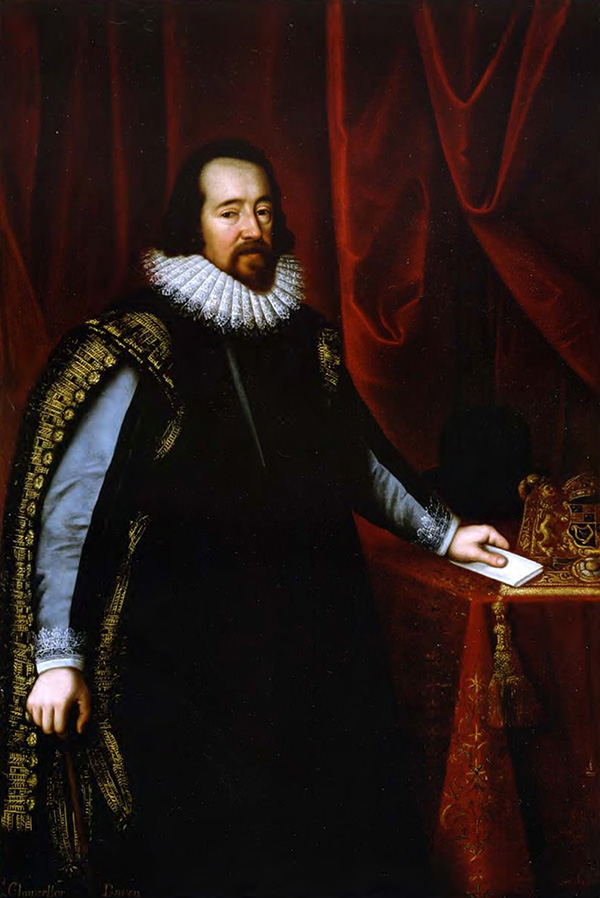
- Life of Sir Francis Bacon
- Life of Anthony Bacon
- Tributes to Sir Francis Bacon
- Bacon Heraldry
- What's in a Name?
- Portraits of Francis Bacon
- The First Queen's Council
- The Bacon Brothers and France
- The Bacon Brothers and Italy
- The French Academy
- Francis Bacon, Shakespeare & the Earl of Essex
- The Missing Head of Bacon
- Canonbury Place & Tower
